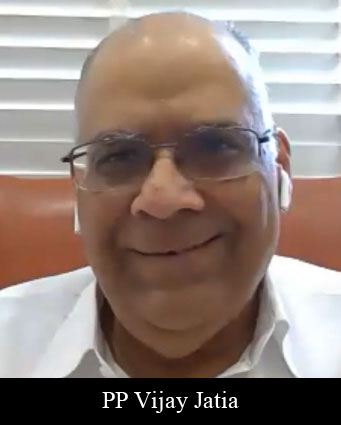
The Path For India’s Private Sector To Launch Into Outer Space Is Bright, Says dr. Chaitanya Giri, A Technology Strategy Analyst
THE SECOND WORLD WAR HELPED MANY WESTERN COUNTRIES TO ACQUIRE HUGE FUND TO SET UP R&D IN THEIR RESPECTIVE COUNTRIES. FOR EXAMPLE, BOEING IN USA OR THE EUROPEAN AERONAUTIC DEFENCE AND SPACE COMPANY (EADS), NOW CALLED AIRBUS, THESE ARE DEVELOPED FROM THE TECHNOLOGIES OF WWII. ONE OF THE BEST OUTCOMES OF WWII WAS SPACE TECHNOLOGY. WHATEVER WE SEE TODAY – SPACE ROCKETS, SATELLITES, THEY HAVE ALL BEEN THE PRODUCT OF WWII.
Last year when India attempted to land on the moon, the moment gathered tremendous movement in the public’s perception. Most of us, young and old, were all glued to our phones till late in the night to see if Chandrayaan 2 reached the moon. How would it land? Would it share the first glimpses? That helped the Government of India to catch
the pulse of our public and this pulse was different 30 years ago. At that time, whenever there was talk of space exploration, it was countered by the argument that we first needed to build toilets, we needed to set our basic amenities right and only then could we start aspiring for fancy things. So, space was considered fancy but that has changed drastically. Space is today an integral part of life.
The communications that we maintain with our friends and families who have gone all over the world to Africa, Europe and Australia – connecting with them is only because of spacebased assets. We can monitor our weather because of space; satellites play a huge role in earth observation – if you want to manage your real estate property, observe farm lands, monitor agricultural activities –but the Government of India kept space activities close to its heart because they have nurtured it since Independence.
There wasn’t much private sector interaction up until the past 10-20 years. Companies like Godrej and KPIT contributed to certain demands of ISRO but were not innovating anything.
Covid-19 came as a blessing in disguise because the reticent Government now felt we should unleash this hidden potential and allow the private sector to work on an equal pedestal with ISRO. That is why space reforms were introduced in May this year.
These reforms included that the private sector be it an MSME, start-up or larger corporation, will be given a level playing field to enter India’s space activities, be a part of space missions, innovate. They may make their own designs, build their own space crafts and satellites and rockets and that will give them the chance to plug into much larger global space economy. The government created new agencies like the Indian National Space Promotion and Authorisation Centre (IN-SPACE) to create this level playing field. There is also a company called New Space India Limited, NSIL that will procure technologies built by our space agencies and sell it in commercial markets in India as well as globally and the private sector will be given a free hand to venture in to deep space. Go to the moon, go to Mars, build technology that will take them there, technologies that will help humans go and let them stay there for longer time. So, the future is very bright hereafter, for India’s space programme.
Coming to the hierarchy of India’s space apparatus: at the top, is the Prime Minister. The PM controls two very crucial departments. One is the Department of Space and the other is the Department of the Atomic Energy. Dept of Space is connected to several laboratories all over India from Gujarat, Kerala, Andhra Pradesh, Tamil Nadu, Madhya Pradesh.
ISRO has been given the task to hand-hold the private sector and show them the way to get into the global space industry. But some of our space players have been intrepid and chartered their own paths. Two examples: Airtel which is Bharti Global and the other is NELCO, a subsidiary of Tata’s.
The crux of this is that the socio-economics in 21st century will depend entirely on connectivity and if you have been following some of the larger socio-economic plans of the country, they have been revolving around five words.
- Last mile connectivity – a term that is part of all government policy papers,
- Rurban – rural plus urban,
- Cillage – city plus village,
- Gramoday – the rise of villages
- P.U.R.A. – Providing Urban Amenities to Rural areas.
The first and foremost missing thing in rural areas is connectivity. Space technology will bridge this and that is why private sector players from all over the world are venturing into the space industry. The satellite industry which is dominated by the private sector constitutes almost US$ 26 billion of the entire US$ 30 billion space market and the non-satellite industry includes only US$ 4 billion. Within that India’s share is US$ 4.3 billion because our space programme is entirely supported by the Government. There is minimal private sector participation but the new reforms will change this. Private sector players from India will eventually get into this quartet, at the top of the quartet is the space industry, then the services industry for space-based applications, then a subset which will build equipment and then the end user which are the applications. So, you will find that in coming years, you will have mobile applications on mobile phones which will provide you with data that is gathered from outer space, located in earth’s orbit. So, there is an immense market which is coming up.
A high-altitude balloon has been launched by LOON, a subsidiary of Alphabet – the parent company of Google. Google is attempting to provide last mile connectivity to many parts of Africa because Africa is the last place to be explored for industries all over the world. Google is venturing out in providing internet and 5G services through these balloons. So, you have a balloon and you have a small satellite-like structure attached to it at the bottom of the balloon that carries transponders. These transponders communicate with ground-based stations which disseminate data to receiving mobile phones or gadgets that you may find in the deserts of Sahara or remote regions. This is a very Africa-centric project.
The balloon was launched from Puerto Rico in the Caribbean and has travelled all through the South Atlantic. Then it went into the Indian Ocean where it was carried by the wind current and it eventually entered Kenya where it was steered and it started transmitting data that was built there. In the coming days and months, LOON will launch many such balloons that will provide connectivity to remote areas. They have also shown interest in providing internet services to remote parts of India, particularly the North East. But in the scheme of these things you have companies like Jio which are growing like behemoths.
How is Jio placed? It is an Indian digital services company that provides 5G and 4G networks in a conventional manner, bringing in optic fibre cables to our homes and providing high speed data. It also has a back-end R&D department but it does not yet have space technology company in its ambit.
Now, let’s come to Google. Google is not a hardware company; it is a services company. It has tied up with Telesat which builds satellites and Telesat gives the hardware to Google. Likewise, Facebook is also a service company but it is also tied up with Maxar, an American satellite manufacturing company. Maxar provides R&D to Facebook. Both Google and Facebook are in the race to build satellite constellations that will go in Earth’s orbit. There will be multiple satellites serving the same purpose and these satellites will transmit data all over the world without any need for ground-based towers. I believe Jio will go the same way in the next few quarters, they are in talks about it.
Another important company is Bharti Global, parent of Airtel. They have taken everyone by surprise in acquiring shares in a company called OneWeb. OneWeb is a Virginia-based company with Airtel as one of its stake holders, and the UK Government being the other. Both are resurrecting OneWeb and will soon provide space-based internet services and 5G and 6G services. 6G is the next generation of telecom services.
Airtel has deep roads in the African market, they have provided 3G services in Africa and continue to be one of the biggest players there. With OneWeb they will penetrate further into areas where they do not have access and eventually, they will acquire huge share of the space-based telecommunications market. Jio has gone the optical fibre way and Airtel has gone the satellite internet way. That is a very peculiar thing to happen and all this has happened without any support from ISRO. So, these companies know their markets and their future. They are out there to reap dividend.
OneWeb has user terminals which are modem like equipment that can be kept at home. They have networks of ground stations all over the world which will receive data from satellites and transfer it to receivers in offices and homes. Airtel will provide these services in India. That is the next revolution. The company building satellites for OneWeb and Airtel is Airbus which is an aircraft company and a subsidiary active in the space company. So, Indian companies are now becoming part of the global and space technology ecosystems and this is a promising sign.
Industry has always been part of space activities. Be it in USA or the former USSR, whenever there is democracy or a free open market, there is scope for creativity. Industry flourishes and unleashing the industry’s creativity becomes the foremost responsibility of the government. With the space reforms of 2020, the government has responded to that creativity.
Why are these changes happening so suddenly? As you know, we are at the doorstep of the 4th Industrial Revolution which also means that we are at the doorstep of the second space age. The first space age began with the Sputnik movement when Russia launched the satellite, triggering a race with the USA and eventually the USA zoomed past Russia. This took about 60 years. In 2020, we are now in the 4th Industrial age. There are tech spin-offs like excessive digitisation, limited fossil fuel, electric vehicles, hydrogen-powered vehicles, heavy use of robotics. This will also spill over into the type of technologies that will be built hereafter and that is why we are at the doorstep of the second space age. For the same reason, many countries are pushing the private sector to come out and get into the global space industry, grow their stakes and help the countries sustain the next generation-economies.
So, the second space age has already begun. More than 280 small satellites that were launched in 2017. Why small? For a long time, we heard of satellites launched from French Guiana in the Caribbean. They were launched by a company known as Ariane. Our communications satellites which then weighed around 3 tonnes kilogram, were launched from French Guiana because we were not capable of launching heavier satellites. Slowly, as the world moved towards the 4th Industrial age, these satellite sizes shrunk. They shrunk in the same manner as our televisions, mobile phones and typewriters. Miniaturization is a hallmark of the 4th Industrial Revolution and that has happened in the satellite sector as well. Today we launch around 400 nano satellites which are small satellites, every year. That means even smaller rockets can now launch these satellites because these satellites are small in size and they don’t weigh so much. That is why Indian start-ups such as Vikram Aerospace and Agnikul want to enter this market and be the carriers of satellites. They will be the goods carrier of our space-based assets.
Countries like Luxemburg, UAE or New Zealand who have never had a space agency before, who were never in the space industry, have suddenly caught the fancy of space sectors. Luxemburg is keen on mining asteroids and the moon. They have made strong policy-level reform within their government. It’s the same with New Zealand which is currently the leader of small satellite launches. There is also an Emirati Mission, Hope, going to Mars. City states are now interested in venturing into space. You also have cars built by Toyota in association with Japanese Space Agency and in the next 10 years or so, cars will travel on the surface of the moon. This has been chosen as a vehicle of interest by the Americans, especially in the current Trump administration, who wants to take humans back to the moon and help them settle for longer durations than the Apollo era astronauts. If they settle there for a longer duration, they will need vehicles. These are all electric and hydrogen-powered vehicles.
I conclude with a quick glimpse of Mumbai. We have the Colaba Geomagnetic Observatory where our space programme began in the 1800s. That was when telegraph was invented, telegraph cables were laid all over the world by the Dutch, the French and the British, through the East India companies. They wanted an observatory that could monitor the well-being of those tele-communication lines which were important for them at that point of time.
That is where our space programme began. Eventually, as we came closer to Independence, Indian physicists and chemists took charge of what would make the post-Independence strategic programme. Mumbai played an important role because of two important laboratories: the National Physical Laboratory in Delhi and the National Chemical Laboratory in Pune which played stellar roles before the establishment of ISRO in setting the 1st plinth of our space programme. All that began from the Institute of Science, once known as the Royal Institute of Science, now under the Government of Maharashtra.
Our very own Mumbaikar, Homi Bhabha was the first to initiate the use of balloons for meteorological measurements. He set up a balloon facility in Hyderabad which still exists but it has not commercialised the way Google has done with LOON. Vikram Sarabhai, though he was not a Mumbaikar, but many of the institutions that were built in Ahmedabad had deep financial linkages with Mumbai. The Vikram Sarabhai Library is maintained by the TCS. When he was alive, he was able to get samples from the moon which were procured by Apollo 11 mission and some of the samples came to TIFR in Colaba in 1970s. Mumbai has its fair share of contribution to early years of India’s space programme but it eventually dwindled in the past few decades. But Mumbai will find its way.
In this decade of 2020, many space agencies including the Indian ones want to explore the moon, particularly the South Pole of the moon because it has huge reserves of water and ice which can be used to set up human establishments. And, by the decade of 2040s, the goal is to send humans to Mars for long duration missions. Let me tell you, this is not a feat that will be accomplished by one country even if it is a powerful country like the USA. It will be a cooperative affair undertaken by diplomatic means, through international linkages and partnerships and these partnerships will not be limited to space agencies and government levels but it will spill over to academic level partnerships and the future is bright.
In conclusion, the Artemis Program of the Americans, wanting to send astronauts, rovers, vehicles, all in the span of next 10 years to the moon, I am sure the space start-ups will play a huge role in fulfilling that ambition.












